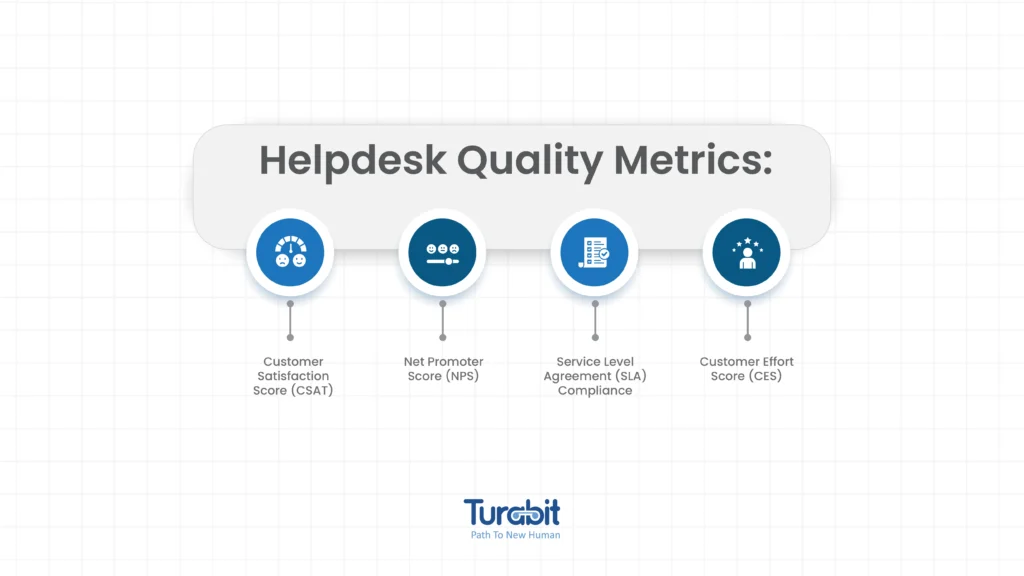In IT support, metrics like CSAT, NPS, SLA Compliance, and CES aren’t just numbers, they’re the Help Desk Quality Metrics to delivering exceptional customer experiences.
These metrics help measure performance, streamline workflows, and improve satisfaction. In this article, we’ll break down these essential KPIs, why they matter, and how you can leverage them for quality support operations.
Let’s dive in!

1. Customer Satisfaction Score (CSAT)
Customer Satisfaction Score (CSAT) is a direct and effective way to measure how happy customers are with the IT support they receive. This metric helps companies evaluate their support quality, pinpoint areas for enhancement, and understand customer expectations.
Why CSAT Matters?
CSAT provides clear, actionable feedback from users, letting support teams know whether they are meeting customer expectations. It’s a real-time metric, capturing reactions immediately after support interactions.
How CSAT is Measured?
Typically, CSAT is measured through a quick survey asking customers to rate their satisfaction on a scale of 1-5 or 1-10, where:
Formula: CSAT (%) = (Total number of satisfied customers ÷ Total number of survey responses) × 100
If 50 out of 60 survey respondents rate their satisfaction as 4 or higher, the CSAT score would be:
(50 ÷ 60) × 100 = 83.33%
Best Practices for Tracking CSAT:
By tracking CSAT consistently, you can get a pulse on customer satisfaction, quickly adapt to changing needs, and continuously improve the quality of support your team delivers.
2. Net Promoter Score (NPS)
Net Promoter Score (NPS) is a widely recognized metric that evaluates customer loyalty, helping businesses gauge how likely customers are to recommend a company’s products or services to others.
This score provides insight into customer satisfaction, offering an essential measure of brand perception.
Why NPS is Important?
NPS is considered a vital metric for understanding the relationship between customers and a company. A higher NPS suggests strong customer loyalty, while a lower score highlights areas for improvement.
It also helps companies track their progress over time and evaluate the success of initiatives aimed at improving customer experience.
How NPS is Measured?
The metric is typically collected via a simple survey question:
“On a scale of 0-10, how likely are you to recommend our company/products/services to a friend or colleague?”
Formula for NPS:
NPS = Number of Promoters – Number of Detractors
If 60% of respondents are Promoters and 20% are Detractors, the NPS score would be: 60% – 20% = 40
Interpreting NPS:
Best Practices for Using NPS:
By tracking NPS, companies can gain critical insights into customer loyalty and identify actionable steps to improve customer satisfaction and retention.
3. Service Level Agreement (SLA)
Service Level Agreement (SLA) Compliance is a key metric that gauges how effectively an IT support team is meeting the service level expectations set in an agreement with customers.
An SLA is a formal contract that outlines the types of support offered, response times, and issue resolution targets, ensuring both the IT team and customers have clear expectations.
Why SLA Compliance is Important?
Tracking SLA compliance is crucial for maintaining customer satisfaction and ensuring that your team is delivering on the commitments made.
When support is delivered within the defined timeframes, customers are more likely to feel valued, improving their loyalty and leading to better retention rates.
Consistently meeting SLA standards can also enhance your organization’s reputation as a reliable provider.
How SLA Compliance is Measured?
SLA compliance is measured by comparing the number of issues resolved within the agreed-upon timeframe to the total number of tickets received within that period.
It helps track how well your team is adhering to the promises made in your SLA, and provides insights into operational efficiency.
Formula for SLA Compliance:
SLA Compliance = (Requests Resolved within SLA / Total Requests) × 100
For example:
If your team resolves 80 out of 100 requests within the agreed time, SLA Compliance is: (80 / 100) × 100 = 80%
Interpreting SLA Compliance:
Best Practices for Using SLA Compliance:
By closely tracking SLA compliance, businesses can improve their IT support efficiency, enhance customer satisfaction, and strengthen their reputation for reliable service delivery.
4. Customer Effort Score (CES)
Customer Effort Score (CES) is a metric that gauges the ease or difficulty of a customer’s experience when interacting with a support team.
The primary goal of CES is to measure how much effort the customer had to invest in getting their issue resolved or completing a transaction. The lower the effort required, the better the overall customer experience.
Why CES is Important?
CES is critical because it reveals friction points in the customer journey. When customers have to put in too much effort to resolve an issue, their satisfaction and loyalty can significantly decrease.
This metric helps organizations identify where processes or systems can be improved to reduce customer effort, ultimately enhancing the customer experience.
How CES is Measured?
CES is typically measured by a simple question asked after a support interaction: “How much effort did you have to put forth to handle your request?” Customers are then asked to rate their experience on a scale from:
This simple but effective question helps companies measure how much effort customers feel they exerted in resolving their issues.
Formula for CES:
CES = (Total Effort Score / Total Responses)
For example: If 100 customers respond with an average effort score of 3, the CES would be: CES = 3 (on a scale of 1 to 5)
Interpreting CES:
Best Practices for Using CES:
By tracking CES, businesses can gain valuable insights into their support processes and make adjustments to enhance customer satisfaction and loyalty.
All in all
IT support isn’t just about fixing issues, it’s about delivering seamless experiences that keep customers satisfied and loyal. Metrics like CSAT, NPS, SLA Compliance, and CES are your roadmap to success.
With Tuva IT and its powerful integrations, you can streamline workflows, reduce inefficiencies, and empower your team to deliver faster, smarter support.
By optimizing processes and enhancing collaboration, Tuva IT helps drive better outcomes across these key metrics, ensuring your team consistently exceeds expectations.
Related read: 15 Key Help Desk Metrics to Track IT Support Performance

